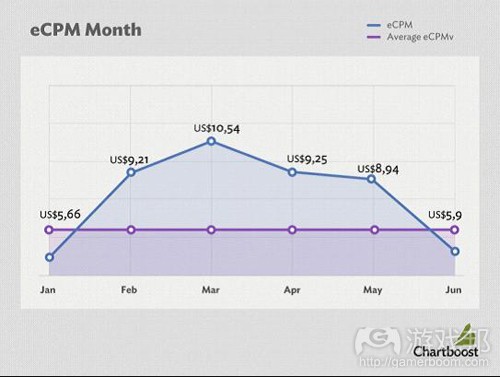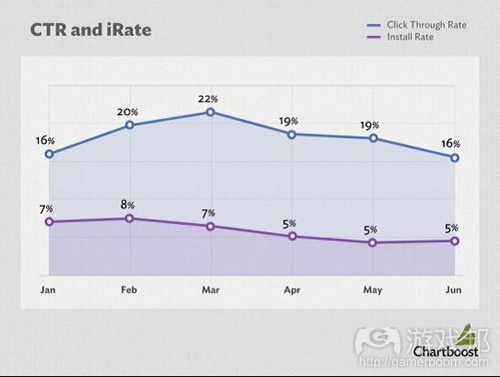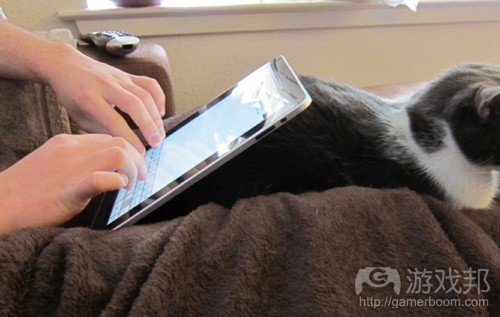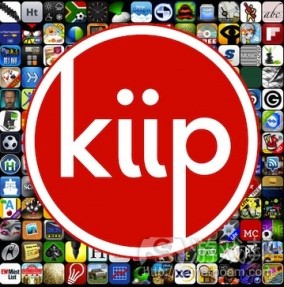每日观察:关注平板电脑用户与广告互动情况(7.18)
1)据科技博客Technode报道,中国前十大应用开发商平均仅有1.53%收益来自中国市场。应用商店分析及营销服务公司App Annie数据则显示,中国前十大开发商多为游戏开发公司。
为提高创收水平,不少中国开发者采用Chartboost盈利解决方案以开拓海外市场,有一家匿名中国开发商在Chartboost网络每日创收3500美元,值得注意的是这是一家去年刚成立,并且仅有20名成员的自主筹资公司。
该团队通过中国网络科技论坛找到Chartboost,并于2012年1月在自己的应用中植入Chartboost平台,在3月份就发现应用中的广告点击率达到22%,eCPM平均值超过10.5美元,经过对其他盈利解决方案的测试和对比之后,他们决定与Chartboost合作,并在6月份创收7万7450美元;最近他们还使用Chartboost的Direct Deal技术通过一家广告合作伙伴实现了3美元的CPI。
2)Interactive Advertising Bureau (IAB)最新调查报告显示,平板电脑用户与广告互动频率较高,47%受访者自称每周每次至少与平板电脑上的广告互动一次,而智能手机用户与广告互动的比例仅为25%。
值得注意的是,这些移动设备用户与广告互动后,就极有可能采取消费行动,智能手机用户的这一比例为80%,平板电脑用户比例为89%。
报告还指出,一天当中的特定时间也会对用户使用移动设备的习惯产生直接影响。对智能手机用户来说,最有效的媒体时间包括:清晨,睡醒后访问社交媒体的用户比例将近20%;中午,近三分之一(28%)用户表示自己会在此时访问媒体内容;晚上黄金时段,在看电视的黄金时间,用户消费一般媒体及社交媒体内容的比例上升到高峰。
平板电脑用户的有效媒体时间则相对缺乏准确性,目前仅知在清晨时分有28%用户会通过平板电脑访问社交媒体。
从地理位置来看,30%智能手机用户和32%平板电脑用户表示更愿意与自己当前所在地相关的广告互动,但这里的“当前所在地”多为用户家里而非其他地点。
3)据Develop报道,Zynga首席运营官John Schappert在最近采访中表示,休闲、社交及手机游戏可让所有人成为游戏玩家。他称休闲和手机游戏才是行业的未来,因此离开EA和主机游戏领域并加入Zynga。
他表示自己爱玩游戏,但可用于享受40小时游戏体验的时间越来越少,但却能花10分钟、15分钟体验短暂的游戏。现在即使是传统游戏领域也不可忽视社交游戏市场,他们在制作AAA级游戏时也需要摆脱旧思维,考虑当今玩家所在平台。
4)据socialgamesobserver报道,移动奖励平台Kiip日前宣布在B轮融资中筹得1100万美元,该轮融资由Relay Ventures主导,其他主要支持者包括Hummer Winblad和True Ventures。该公司将利用这笔资金扩大Kiip奖励网络,并推出一个面向用户的新产品,加强公司与获得Kiip奖励的用户之间的互动。
5)据gamasutra报道,《帝国时代》开发商Ensemble Studios前首席执行官及联合创始人Tony Goodman最近在达拉斯成立新工作室PeopleFun,面向移动设备及其他新兴平台开发游戏。
PeopleFun团队由Ensemble元老组成,其中包括Ensemble前主程序员angelo Laudon、联合创始人John Boog-Scott等,他们已在2011年底投入开发PeopleFun首款游戏。
据Goodman所称,PeopleFun首个项目从规模和题材来看都不同于Ensemble和Robot Entertainment作品(Goodman三年前在德克萨斯州创办的另一家公司)。
6)据《华尔街日报》报道,近日有传闻称iPhone 5将采用内嵌式触控技术(in-cell touch)的屏幕。使用该技术可减少设备的厚度以确保iPhone 5维持轻薄特点,同时还能提升屏幕画面质量。
对苹果来说,采用这一新技术也有助于简化硬件供应环节,减省从不同供应商采购触控面板和LCD面板的成本。(本文为游戏邦/gamerboom.com编译,拒绝任何不保留版权的转载,如需转载请联系:游戏邦)
1)San Francisco-Based Startup Chartboost Is Helping Chinese Mobile Game Developers Monetize the International Mobile Games Market
Game developers around the world are discovering the value of Chartboost to monetize their games in the international markets, particularly in the fast-growing Asian developer markets such as China. These Chinese “unsung heroes”, often preferring to remain anonymous about their app successes overseas (due to domestic piracy concerns), together are earning six figures in US Dollars per month on the Chartboost platform. Dozens of Chinese game developers are now monetizing their iOS and Android apps by making deals with and promoting apps from Chartboost’s growing network of more than 1,500 games.
Driven by an immature and fragmented mobile market in Mainland China, game developers are using Chartboost to address and capture a large and monetizable international market. According to a recent report by Beijing-based English tech blog Technode, the Chinese market only accounted for an average of 1.53% of the Top 10 developers’ total revenue. Beijing-based App Annie, a Apple Store Analytics and Market Intelligence firm, has found that the these top 10 Chinese players are mostly game developers.
Even small, independent iOS and Android developers have grown to be significant by publishing interstitials through Chartboost’s Direct Deals and game-only cross-promotion network. One typical Chinese developer, who is based in Northern China and prefers not to be named, is making up to $3,500 per day on the Chartboost network. Their company, a self-funded team of about 20 employees, was founded just last year by two game company veterans.
They discovered Chartboost through Chinese online technology forums and began integrating their apps into the platform in January 2012. By March, they were seeing unbelievable performance: click-through rates of 22% and an average eCPM over $10.50. After testing several other monetization options and settling on Chartboost, they made $77,450 in June.
Recently, they have made a direct deal to earn $3 CPI from an advertising partner using Chartboost’s Direct Deal technology, and hope to continue increasing their eCPMs by taking advantage of deals with other Chartboost games.(source:dropbox)
2)Half of tablet users say they engage with ads more than once a week
by Mike Shaw
Time, place and device all influence mobile ad interaction.
A research report from the Interactive Advertising Bureau (IAB) and its Mobile Marketing Center of Excellence has revealed how receptiveness to advertising and media consumption varies according to device, time and location.
According to the report, there is strong ad interaction from tablet users, with nearly half (47 per cent) saying they engage with ads more than one a week, while 25 per cent of smartphone users say they interact with ads at the same rate.
If those figures are surprising, then prepare to be stunned: once these mobile device users engage with an ad, they are extremely likely to take action (80 per cent for smartphone users and 89 per cent for tablet users).
Time of day also has a direct impact on how mobile devices are used. For smartphone users, the three most impactful media moments of the day are:
Early morning. When they first wake up, nearly 20 percent access social media.
Midday. Almost a third (28 per cent) cite “free time” windows during this time period that allow them to access media.
Primetime evening. Both general media and social media consumption spike during primetime TV viewing hours.
The results for tablet users are less concrete, but early morning stands out as a key social media time, with 28 per cent engaging social media on their tablets when they first wake up.
In regard to location, 30 per cent of smartphone users and 32% per cent of tablet users said that they were more likely to respond to ads that related to their current location. The study makes pains to highlight, however, that “current location” often refers to home rather than somewhere on the go.
Anna Bager, VP and general manager, Mobile Marketing Center of Excellence, IAB, said: “Both tablet and smartphone users show an impressive interest in mobile advertising.
“The key for marketers is looking at how consumers use these devices in different ways, and tailoring brand messages and strategies accordingly.”(source:mobile-ent)
3)Mobile gaming is the future, says Zynga COO
by Mike Shaw
John Schappert reveals why he left EA for the social gaming publisher.
Casual, social and mobile is making everyone a gamer, says Zynga COO.
Former EA COO John Schappert left the publisher and the console business behind for Zynga as he saw casual and mobile gaming as the future of the industry, the development veteran told Mobile Entertainment’s sister publication Develop, in a recent interview.
Schappert shocked many with his decision to leave his position at EA to join the controversial social games giant in 2011, but said the casual space was where he felt games were going.
While he said many consumers still play console games, the mobile and browser space had the potential to attract billions of users.
“It’s where I saw gaming going,” said Schappert.
“When I was at Electronic Arts I worked very closely with the group that had casual, mobile and social, and you just saw the explosive growth that was happening in that. It’s going from a couple of hundred million gamers to everyone being a gamer, billions of people.
“I’ve been in the industry my entire career. I love games, but I look at my own habits: I have fewer and fewer times where I could dedicate 40 hours to a longer play time experience.
“But I find myself dedicating ten, 15 minutes here and there to these short-burst experiences.”
Schappert added that even traditional parts of the industry could not afford to ignore social gaming, and had to look beyond consoles when creating big budget triple-A titles.
“People have to change. You have to think about things differently,” he said.
“You can’t think about $60 games and an installed base of a console. You’ve got to think ‘where are all the gamers today?’ They’re on that iPhone, they’re on Android devices, they’re on tablets, Macintosh, they’re on that PC, they are everywhere.”(source:mobile-ent)
4)Kiip Raises $11M for Expansion and Mobile Rewards Wallet
By Gary Merrett
Kiip today announced that it has successfully raised an $11 million Series B funding round led by Relay Ventures, with participation from existing Series A investors Hummer Winblad and True Ventures, and others. The investment will be used to help the company expand the Kiip rewards network beyond gaming and launch new consumer-facing products to engage millions of consumers that receive Kiip rewards every month. Kiip is the world’s first mobile rewards network that delivers tangible rewards for virtual achievements. The company’s category-creating rewards platform enables brands to reach consumers in the moments when they are most engaged and receptive, while driving revenues and greater user allegiance for Kiip-enabled games and apps.(source:socialgamesobserver)
5)Former Ensemble head Tony Goodman opens mobile studio
by Eric Caoili
Tony Goodman, former CEO and co-founder of Age of Empires maker Ensemble Studios, has opened a new Dallas-based developer dedicated to making games for mobile devices and other emerging platforms.
The new company, PeopleFun, is made up of other veterans from Ensemble, such as the defunct studio’s former lead programmer Angelo Laudon and co-founder John Boog-Scott. They’ve worked on PeopleFun’s first title, which is about to hit beta, since late 2011.
Goodman describes PeopleFun’s first project is as a departure, in terms of scope and genre, from the kind of games he made at Ensemble and Orcs Must Die developer Robot entertainment (another company he founded in Texas three years ago). Ensemble was best known for making real-time strategy titles like Age of Empires and Halo Wars.(source:gamasutra)
6)iPhone 5 will use in-cell tech for thinner screen
by Mike Shaw
And if it’s thinner, it could also be larger.
The Wall Street Journal has added to the iPhone 5 rumour mill by reporting that Apple is expected to use in-cell touch display technology for the new device.
Using in-cell will reduce the thickness of the device while ensuring it remains lightweight – perhaps paving the way for an increased screen size.
The technology integrates touch sensors into the LCD, making it unnecessary to have a separate touch-screen layer. The absence of the layer, usually about half a millimetre thick, not only makes the whole screen thinner, but the quality of displayed images would improve.
For Apple, the new technology would also simplify the supply chain and help cut costs as it would no longer have to buy touch panels and LCD panels from separate suppliers.(source:mobile-ent)















































 闽公网安备35020302001549号
闽公网安备35020302001549号